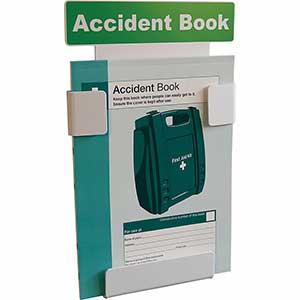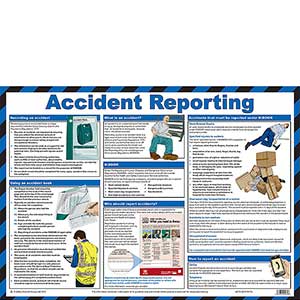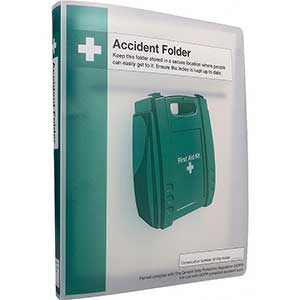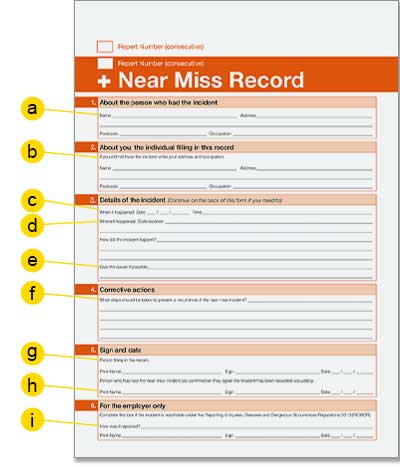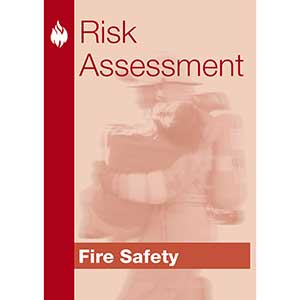
Quick Links:
Accident recording
Accident reporting
Types of RIDDOR-reporting accidents
Responsibility for reporting accidents
Why do workplace accidents need to be recorded and reported?
The UK Health and Safety at work statistics for 2021 highlight the importance of continuing to improve health and safety measures in workplaces: 0.4 million workers sustained a non-fatal injury and 142 workers were killed while at work.
The “The Reporting of Injuries, Diseases and Dangerous Occurrences Regulations 2013” made it a legal requirement for employers or responsible persons to report certain injuries and illnesses to the HSE. By reporting accidents to the relevant authorities, this allows them to understand more about how risks come about and how they can support workplaces to avoid future risks. It also enables them/enables authorities to determine if further investigation of a specific incident is required.
Under “The Social Security (Claims and Payments) Regulations 1979”, it is also the law for any employer of 10 or more people to keep an accident recording system readily accessible by which employees, or someone acting on their behalf, can record accidents. Internal recording of accidents supports workplaces in understanding the causes of accidents and how to prevent them in the future, providing an essential aid to risk assessments.
What is the procedure for accident recording?
Not only do workplaces need to keep records of any accidents that are reportable under RIDDOR, they must also keep records of occupational injuries that result in a worker being unable to perform their normal duties for more than three consecutive days.
It is the law that employers of 10 or more workers should provide a system of recording accidents that is easily accessible for use. These records must then be kept for at least 3 years and stored in a secure place for confidentiality.
There are five key details of accidents legally required: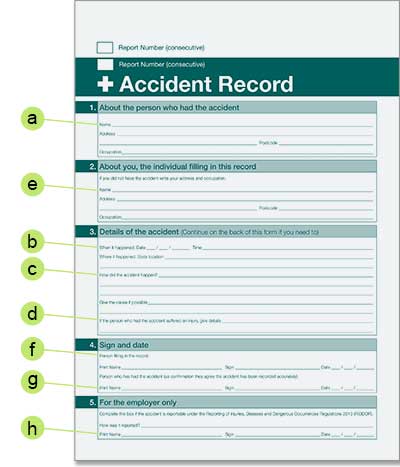
- Full name, address and occupation of the injured person (a)
- Date and time of the accident (b)
- Location of the accident (c)
- Cause and nature of the injury (d)
- Name, address and occupation of the person giving the notice, if other than the injured person (e).
In addition, it is also useful to have a signature from the person recording the incident (f), as well as a signature from the injured person to confirm the details of the incident (g).
Finally, a note of whether the accident has been reported to the HSE under RIDDOR ensures that this has been completed where necessary (h).
Recording accidents in schools
For members of staff, a workplace accident book should be used, as shown above. For pupils, we have created a tailored version of this accident book that considers the information needed by schools:
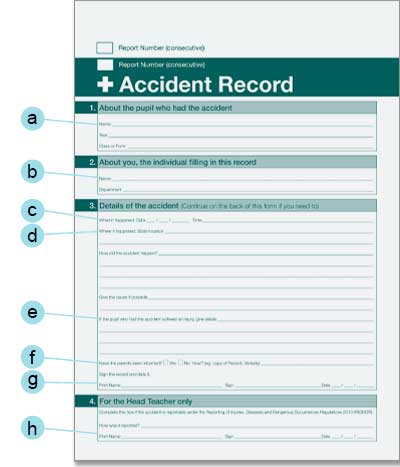
- Full name, year group and class of injured pupil (a)
- Full name and department of person filling out the form (b)
- Date and time of the accident (c)
- Location of the accident (d)
- Cause and nature of the injury (e)
- Additional section to record informing parents or guardians (f)
- Space for the signature of the person recording the incident (g)
- Space for the head teacher, or responsible person, to confirm whether a report was required under RIDDOR (h)
Where to keep an accident book
Accident book stations allow for accident record forms to be easily accessible and can be placed in higher-risk areas/first aid areas as a clear reminder. If placed near informative posters, you can ensure these will be filled out correctly and procedures followed. Accident folders then allow for recorded incidents to be filed away in a secure place, such as a lockable office.
In addition to accidents, it is a good idea to keep a “Near Miss” record book to ensure any dangerous circumstances or events are recorded, even if they didn’t result in accident or injury. Similarly to accident records, these can help with future risk assessments and safety procedures.
What should be included in a “Near Miss” record?
- Full name, address and occupation of the person who experienced the incident (a)
- Name, address and occupation of the person filling in the record, if other than the above (b).
- Date and time of the incident (c)
- Location of the incident (d)
- Description and cause of the incident (e)
- Description of corrective actions (f) to ensure future health and safety measures
- Signature of the person recording the incident (g) and the person who experienced the incident (h)
- A record of whether the accident has been reported to the HSE ensures that this has been completed where necessary (i).
Some “Near Miss” incidents classified as Dangerous Occurrences need to be reported under RIDDOR.
What is the procedure for accident reporting?
Employers, self-employed people and people in control of work premises are required to report certain workplace accidents, occupational diseases and dangerous occurrences to the HSE under RIDDOR.
When to report to the HSE under RIDDOR
Most incidents should be reported within 10 days of the incident. Exceptions to this rule are as follows:
- Incidents that are reported due to over-seven-day incapacitation of a worker – these must be reported within 15 days of the incident
- Cases of occupational disease – these must be reported as soon as the responsible person receives a diagnosis
How to report to the HSE under RIDDOR
Responsible persons can report appropriate accidents, diseases or occurrences online through the HSE. There are different online forms, depending on types of incidents and, for fatal/specified incidents only, there is also a telephone number.
In addition to reporting to the HSE, workplaces must keep their own records of the incident. This can be in an accident or near miss book (also recording the date and method of reporting), or a copy of a RIDDOR form can be downloaded after submitting.
What types of accidents require reporting under RIDDOR?
- Any death of workers or non-workers (excluding suicides) must be reported under RIDDOR if they result from a work-related accident, including acts of physical violence.
- The following injuries to workers must be reported under RIDDOR:
- Fractures, other than to fingers, thumbs and toes
- Amputations
- Injuries likely to lead to permanent loss of, or reduction in, sight
- Crush injuries to the head or torso, resulting in damage to the brain or internal organs
- Serious burns, including scalding, that:
- Cover more than 10% of the body
- Cause significant damag3e to the eyes, respiratory system or other vital organs
- Any scalping that requires hospital treatment
- Loss of consciousness caused by head injury or asphyxia
- Injuries resulting from working in an enclosed space that:
- Lead to hypothermia or heat-induced illness
- Require resuscitation or admittance to hospital for more than 24 hours.
- Accidents that result in employees or self-employed people being unable to perform normal work duties for more than seven consecutive days because of their injury. This timeframe does not include the day of the injury but does include weekends and rest days.
- Non-fatal accidents to non-workers, if they result in the person being taken directly from the accident to hospital for treatment. In this case, examinations and diagnostic tests are not considered “treatment”.
- Occupational diseases that have been made worse or caused by work.
- Diagnosis of a disease after exposure to carcinogens, mutagens or biological agents.
- Dangerous occurrences – a specific list of near misses that have not resulted in death or injury
- Gas-related incidents
What accidents do schools need to report under RIDDOR?
For employees of school, the reporting procedure and the accidents that need reporting is the same as for other workplaces.
For pupils or visitors to the school, the requirements are slightly different, as they are not treated as employees. Injuries to pupils or visitors involved in a school activity only need to be reported under RIDDOR if the following applies:
- A work activity results in the death of a person
- A work activity results in the injury of a person that requires immediate hospital treatment to which they are taken directly from the scene of the accident. This does not include diagnostic tests or examinations).
Such events are only considered to have resulted from a work activity if the accident was caused by any of the following:
- Failure in the organisation of a work activity, e.g. lack of adequate supervision on a school trip
- The way in which equipment or substances were used, e.g. lifts, machinery, experiments
- The condition of the premises, e.g. poorly maintained floors
One exception to this is that if pupils are injured and taken to hospital as a result of another vehicle striking a school bus while pupils are getting on or off that buts, this is usually reportable under RIDDOR.
Road traffic accidents involving school vehicles while they are travelling on the public highway are investigated by the police and not reportable under RIDDOR.
Incidents occurring on overseas trips are not reportable to the HSE, as RIDDOR only applies to events that take place in Great Britain.
Incidents occurring to pupils while on work experience placements are reportable under RIDDOR, as pupils are considered to be employees during the placement. The responsibility for reporting incidents to the HSE in this case falls to the employer where the pupil is completing their work experience.
Who is responsible for reporting accidents?
The duty to report to the HSE under RIDDOR is on the employer, the self-employed person or the responsible person (person in control of work premises).Members of the public, employees, injured persons and their representatives should not report to the HSE. Employees should inform their employers of any event that requires RIDDOR reporting. If they are concerned that their employer or responsible person has not reported to the HSE, they should ask if the report has been made and/or approach their employee or TU representative. If employees or members of the public are still concerned, the HSE provides advice on reporting a health and safety issue.
Gas conveyors, fillers, importers or suppliers also have a duty to report under RIDDOR, if they have learnt of gas supplied by themselves causing death, unconsciousness or hospital treatment. Gas engineers, or their employers, must provide details of any gas fittings that they consider to be dangerous to the extent of causing death, unconsciousness or hospital treatment.
Other accident recording solutions
In addition to the accident record books, workplaces may want to consider our other accident reporting solutions.
Of course, the best place to start is ensuring you have assessed all workplace risks accurately and put appropriate safety measures in place:
Make sure you understand exactly what your workplace needs and that you have the necessary first aid kits and equipment to provide effective first aid in your workplace.
Read our blog for more information on first aid, or contact us for further advice and information on our products.


